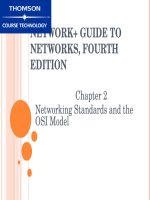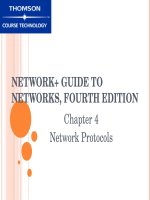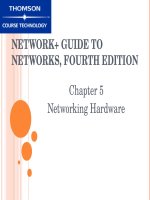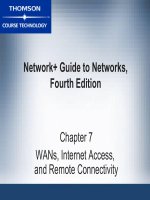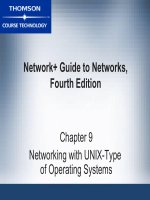NETWORK+ GUIDE TO NETWORKS, FOURTH EDITION - CHAPTER 9 docx
Bạn đang xem bản rút gọn của tài liệu. Xem và tải ngay bản đầy đủ của tài liệu tại đây (347.82 KB, 46 trang )
Network+ Guide to Networks,
Fourth Edition
Chapter 9
Networking with UNIX-Type
of Operating Systems
Network+ Guide to Networks, 4e 2
Objectives
•
Describe the origins and history of the UNIX
operating system
•
Identify similarities and differences between
popular implementations of UNIX
•
Describe the features and capabilities of servers
running Solaris, Linux, and Mac OS X Server
•
Explain and execute essential UNIX commands
Network+ Guide to Networks, 4e 3
Objectives (continued)
•
Install and configure Linux on an Intel-based PC
•
Manage users, groups, and file access permissions
in Solaris, Linux, and Mac OS X Server
•
Explain how computers running other operating
systems can connect to UNIX servers
Network+ Guide to Networks, 4e 4
A Brief History of UNIX
•
UNIX led to development of TCP/IP
•
Numerous vendors sell different UNIX varieties
•
Ken Thompson and Dennis Ritchie developed
UNIX at Bell Labs (part of AT&T)
–
System V
•
UNIX source code was cheaply available from
AT&T
–
Quickly distributed to many organizations
Network+ Guide to Networks, 4e 5
A Brief History of UNIX (continued)
•
Berkeley Software Distribution (BSD): Berkeley
versions of UNIX
–
Added TCP/IP network subsystem to UNIX
•
AT&T sold rights to UNIX
–
Now owned by two groups:
•
The SCO Group owns rights to UNIX source code
•
The Open Group owns UNIX trademark
Network+ Guide to Networks, 4e 6
Varieties of UNIX
•
All flavors of UNIX share the following features:
–
Support multiple, simultaneously logged-on users
–
Coordinate multiple, simultaneously running tasks
–
Mount disk partitions on demand
–
Apply permissions for file and directory access and
modification
–
Uniform method of issuing data to or receiving data
from hardware devices, files, and running programs
–
Start programs without interfering running programs
Network+ Guide to Networks, 4e 7
Varieties of UNIX (continued)
•
All flavors of UNIX share the following features
(continued):
–
Hundreds of subsystems, including dozens of
programming languages
–
Source code portability
–
Window interfaces (e.g., X Windows)
•
Two main categories:
–
Proprietary
–
Open source
Network+ Guide to Networks, 4e 8
Proprietary UNIX
•
Source code either unavailable or available only by
purchasing licensed copy from the SCO Group
–
Mac OS X Server: Apple
•
Runs on PowerPC-based computers
–
Solaris: Sun
•
Runs on SPARC-based workstations and servers,
Intel-based Pentium-class workstations and servers
–
AIX: IBM
•
Runs on PowerPC-based computers
•
Does not run on Macs
Network+ Guide to Networks, 4e 9
Proprietary UNIX (continued)
•
Advantages:
–
Accountability and support
–
Optimization of hardware and software
–
Predictability and compatibility
•
Customer has no access to system’s source code
–
Cannot customize
Network+ Guide to Networks, 4e 10
Open Source UNIX
•
Open source software available to anyone, without
licensing fees
•
Open source UNIX flavors:
–
GNU
–
BSD
–
Linux
•
Users can modify code
–
Add functionality
•
Can be installed on wide range of systems
Network+ Guide to Networks, 4e 11
Three Flavors of UNIX
•
Solaris used by Sun Microsystems on its SPARC-
based servers
•
Linux follows standard UNIX conventions, highly
stable, and free
–
Developed by Linus Torvalds in 1991
–
Widely supported and used
•
Mac OS X Server: Runs on Apple’s Xserve line of
computers as well as Power Mac computers
•
All support TCP/IP and other protocols
•
Support many network topologies and physical
media
Network+ Guide to Networks, 4e 12
UNIX Server Hardware Requirements
•
Any UNIX-type OS can act as a workstation or
server OS
•
Use of GUI optional
–
Command line interface
•
To estimate additional hardware required:
–
Server usage?
–
Applications and services to be run on server?
–
Number of users?
–
Peak usage time periods?
–
Maximum tolerable downtime?
Network+ Guide to Networks, 4e 13
Solaris Hardware Requirements
Table 9-1: Minimum hardware requirements for Solaris 10
Network+ Guide to Networks, 4e 14
Linux Hardware Requirements
Table 9-2: Minimum hardware requirements for a Linux server
Network+ Guide to Networks, 4e 15
Mac OS X Server Hardware
Requirements
Table 9-3: Apple hardware recommendations for Mac OS X
Server
Network+ Guide to Networks, 4e 16
A Closer Look at UNIX: UNIX
Multiprocessing
•
Allocate separate resources (e.g., memory space)
to each process as it is created
–
Enables partitioning of processes in memory
–
Prevent programs from disrupting operation of entire
system
•
Support symmetric multiprocessing (SMP)
–
Solaris: up to 128 processors
–
Linux: up to 32 processors
–
Mac OS X Server: up to 2 processors
Network+ Guide to Networks, 4e 17
The UNIX Memory Model
•
Use both physical and virtual memory efficiently
•
Allocate memory area for each application
–
Sharing memory between programs wherever
possible
•
Increases efficiency
•
Most use 32-bit addressing scheme
–
Enables programs to access 4 GB of memory
•
Most can run on CPUs employing 64-bit addresses
•
Virtual memory: disk partition or a file
Network+ Guide to Networks, 4e 18
The UNIX Kernel
•
Core of all UNIX-type of systems
–
Loaded into memory and runs computer turned on
–
Coordinates access to computer’s hardware
–
Can add or remove functionality by loading and
unloading kernel modules
•
Files containing instructions for performing specific
tasks
•
Kernel origins:
–
Solaris: original AT&T UNIX software
–
Linux: Linus Torvalds
–
Mac OS X Server (XNU): Mach
Network+ Guide to Networks, 4e 19
UNIX System File and Directory
Structure
•
First OSs to implement hierarchical file system
–
/boot directory contains kernel and other system
initialization files
–
Applications and services stored in /bin and /sbin
directories
–
/var directory holds variable data
–
Users’ login directories typically in /home
•
/Users on Mac OS X Server
Network+ Guide to Networks, 4e 20
UNIX System File and Directory
Structure (continued)
Figure 9-1: UNIX file system hierarchy
Network+ Guide to Networks, 4e 21
UNIX System File Services
•
Disk File Systems:
–
OS’s facility for organizing, managing, and accessing
files through logical structures and software routines
–
Native file system type on Linux is ext3
–
Solaris employs UFS
–
Mac OS X Server employs HFS+ file system
–
Can access FAT and NTFS partitions
Network+ Guide to Networks, 4e 22
UNIX System File Services
(continued)
•
Network File Systems (NFSs): analogous to
Windows shares or NetWare network volumes
–
Attach shared file systems (or drives) from Windows,
NetWare, or other UNIX servers and share files with
users on other computers
–
Sun Microsystems’ NFS
–
Samba: open source application that implements
Windows SMB and CIFS file system protocols
•
Included with Solaris, most Linux distributions, and
Mac OS X Server systems by default
–
Mac OS X Server uses AFP
Network+ Guide to Networks, 4e 23
A UNIX Command Sampler
•
Command line is primary method of interacting with
UNIX-type systems
•
Command interpreter (shell): program that accepts
and runs typed commands
–
Primary UNIX command interpreter file is /bin/sh
•
Every UNIX-type system contains full
documentation of UNIX commands in manual
pages (man pages)
–
Access via man command
Network+ Guide to Networks, 4e 24
A UNIX Command Sampler
(continued)
•
Nine man page sections:
–
Section 1 covers commands most typically entered
–
Sections 2 through 5 document programmer’s
interface to UNIX system
–
Section 6 documents some amusements and games
included in UNIX system
–
Section 7 describes device drivers
–
Section 8 covers commands used by administrators
to manage system
–
Section 9 documents UNIX kernel functions
programmers use when writing device drivers
Network+ Guide to Networks, 4e 25
A UNIX Command Sampler
(continued)
•
apropos command: find possible manual page
entries for a command
•
Most commands are lowercase alphabetic
characters
•
To specify an option, usually type a hyphen (-)
followed by a letter
•
File globbing: equivalent to using wildcards in
Windows and DOS
•
UNIX directory separator character is “/”

